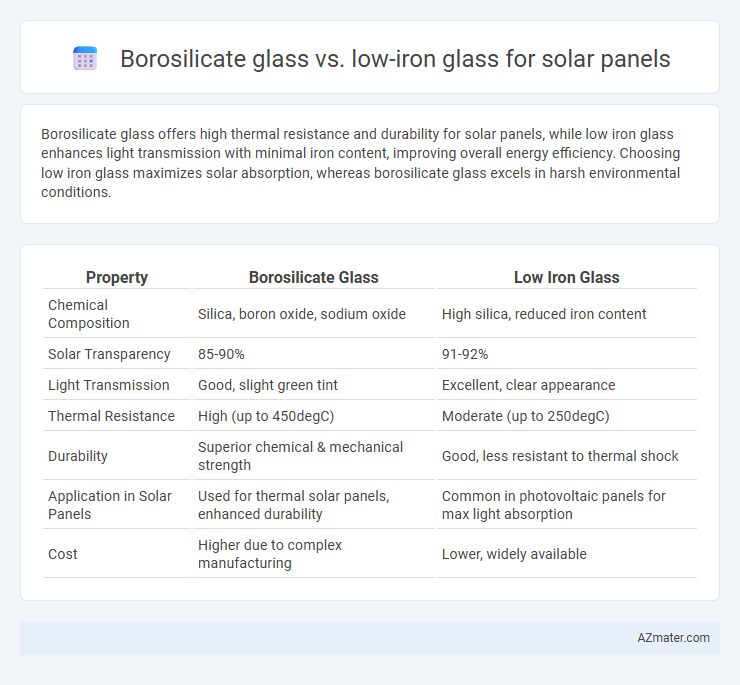Borosilicate glass offers high thermal resistance and durability for solar panels, while low iron glass enhances light transmission with minimal iron content, improving overall energy efficiency. Choosing low iron glass maximizes solar absorption, whereas borosilicate glass excels in harsh environmental conditions.
Table of Comparison
| Property | Borosilicate Glass | Low Iron Glass |
|---|---|---|
| Chemical Composition | Silica, boron oxide, sodium oxide | High silica, reduced iron content |
| Solar Transparency | 85-90% | 91-92% |
| Light Transmission | Good, slight green tint | Excellent, clear appearance |
| Thermal Resistance | High (up to 450degC) | Moderate (up to 250degC) |
| Durability | Superior chemical & mechanical strength | Good, less resistant to thermal shock |
| Application in Solar Panels | Used for thermal solar panels, enhanced durability | Common in photovoltaic panels for max light absorption |
| Cost | Higher due to complex manufacturing | Lower, widely available |
Introduction to Solar Panel Glass Types
Borosilicate glass offers high thermal resistance and durability, making it ideal for solar panels exposed to extreme temperature variations. Low iron glass enhances light transmission by reducing iron content, which improves solar panel efficiency through increased sunlight absorption. Both glass types are crucial in optimizing energy output and longevity of solar panel installations.
What is Borosilicate Glass?
Borosilicate glass is a type of glass known for its high thermal resistance and durability, making it ideal for solar panel applications where temperature fluctuations occur. It contains boron trioxide, which enhances its strength and reduces thermal expansion compared to standard glass types. Unlike low iron glass, which offers superior light transmittance due to reduced iron content, borosilicate glass provides enhanced mechanical stability and resistance to environmental stress.
What is Low Iron Glass?
Low iron glass is a specialized type of glass with reduced iron content, resulting in higher light transmittance and minimal greenish tint compared to standard glass, making it ideal for solar panel applications. This enhanced clarity improves solar efficiency by allowing more sunlight to reach photovoltaic cells, boosting energy output. Unlike borosilicate glass, low iron glass offers superior optical performance but with lower thermal and chemical resistance.
Key Differences Between Borosilicate and Low Iron Glass
Borosilicate glass offers superior thermal resistance and durability, making it ideal for solar panels exposed to harsh environmental conditions. Low iron glass provides higher light transmittance, enhancing solar panel efficiency by allowing more sunlight to reach photovoltaic cells. The key differences lie in borosilicate's chemical composition, which reduces thermal expansion, versus low iron glass's optimized iron content that minimizes green tint and maximizes clarity.
Optical Clarity and Light Transmission Comparison
Borosilicate glass offers high thermal resistance but generally lower optical clarity compared to low iron glass, which is engineered specifically for superior transparency in solar panel applications. Low iron glass typically achieves light transmission rates above 91%, enhancing solar energy absorption, whereas borosilicate glass commonly transmits around 88-90%. The enhanced optical clarity and higher light transmission of low iron glass contribute to improved photovoltaic efficiency by maximizing the amount of solar radiation reaching the solar cells.
Durability and Thermal Stability
Borosilicate glass offers superior durability and thermal stability compared to low iron glass, making it highly resistant to thermal shock and mechanical stresses in solar panel applications. Its low coefficient of thermal expansion allows solar panels to withstand rapid temperature changes without cracking, enhancing lifespan. Low iron glass, while providing excellent light transmittance, generally lacks the robust thermal resistance and mechanical strength characteristic of borosilicate glass, potentially reducing long-term durability.
Chemical Resistance in Solar Applications
Borosilicate glass offers superior chemical resistance compared to low iron glass, making it more durable against environmental factors such as acidic rain and industrial pollutants in solar panel applications. Its low coefficient of thermal expansion and high resistance to alkaline and acidic substances reduce the risk of degradation and surface etching, thereby extending the lifespan of solar modules. Low iron glass, while optimized for higher light transmittance, lacks the robust chemical stability required for harsh environmental exposure, potentially leading to faster deterioration in solar arrays.
Cost Effectiveness and Availability
Borosilicate glass offers superior thermal and chemical resistance for solar panels but tends to be more expensive and less readily available compared to low iron glass. Low iron glass, widely used in solar applications, provides excellent light transmission at a lower cost, making it more cost-effective for large-scale solar panel production. Availability of low iron glass is higher globally, supporting its preference in cost-sensitive solar projects.
Performance Impact on Solar Efficiency
Borosilicate glass offers superior thermal resistance and durability, reducing micro-cracks and thus maintaining optimal solar panel efficiency over time. Low iron glass enhances light transmittance by minimizing iron content, increasing solar energy absorption and improving overall panel performance. Compared to borosilicate, low iron glass typically provides higher initial solar efficiency due to its clearer appearance but may lack the long-term resilience against environmental stress.
Choosing the Right Glass for Solar Panels
Borosilicate glass offers superior thermal resistance and durability, making it ideal for solar panels exposed to harsh environmental conditions. Low iron glass provides higher light transmittance, enhancing solar panel efficiency by allowing more sunlight to reach the photovoltaic cells. Selecting the right glass depends on balancing factors like environmental exposure and energy yield requirements for optimal solar panel performance.

Infographic: Borosilicate glass vs Low iron glass for Solar panel
 azmater.com
azmater.com